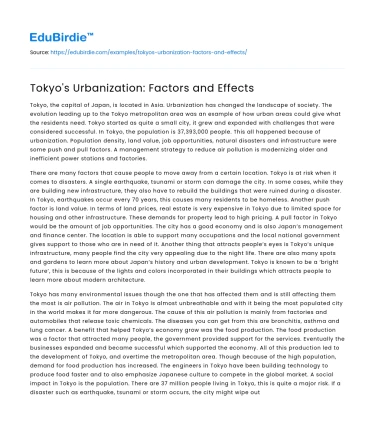Tokyo, the capital of Japan, is located in Asia. Urbanization has changed the landscape of society. The evolution leading up to the Tokyo metropolitan area was an example of how urban areas could give what the residents need. Tokyo started as quite a small city, it grew and expanded with challenges that were considered successful. In Tokyo, the population is 37,393,000 people. This all happened because of urbanization. Population density, land value, job opportunities, natural disasters and infrastructure were some push and pull factors. A management strategy to reduce air pollution is modernizing older and inefficient power stations and factories.
There are many factors that cause people to move away from a certain location. Tokyo is at risk when it comes to disasters. A single earthquake, tsunami or storm can damage the city. In some cases, while they are building new infrastructure, they also have to rebuild the buildings that were ruined during a disaster. In Tokyo, earthquakes occur every 70 years, this causes many residents to be homeless. Another push factor is land value. In terms of land prices, real estate is very expensive in Tokyo due to limited space for housing and other infrastructure. These demands for property lead to high pricing. A pull factor in Tokyo would be the amount of job opportunities. The city has a good economy and is also Japan’s management and finance center. The location is able to support many occupations and the local national government gives support to those who are in need of it. Another thing that attracts people’s eyes is Tokyo’s unique infrastructure, many people find the city very appealing due to the night life. There are also many spots and gardens to learn more about Japan’s history and urban development. Tokyo is known to be a ‘bright future’, this is because of the lights and colors incorporated in their buildings which attracts people to learn more about modern architecture.
Save your time!
We can take care of your essay
- Proper editing and formatting
- Free revision, title page, and bibliography
- Flexible prices and money-back guarantee
Tokyo has many environmental issues though the one that has affected them and is still affecting them the most is air pollution. The air in Tokyo is almost unbreathable and with it being the most populated city in the world makes it far more dangerous. The cause of this air pollution is mainly from factories and automobiles that release toxic chemicals. The diseases you can get from this are bronchitis, asthma and lung cancer. A benefit that helped Tokyo’s economy grow was the food production. The food production was a factor that attracted many people, the government provided support for the services. Eventually the businesses expanded and became successful which supported the economy. All of this production led to the development of Tokyo, and overtime the metropolitan area. Though because of the high population, demand for food production has increased. The engineers in Tokyo have been building technology to produce food faster and to also emphasize Japanese culture to compete in the global market. A social impact in Tokyo is the population. There are 37 million people living in Tokyo, this is quite a major risk. If a disaster such as earthquake, tsunami or storm occurs, the city might wipe out. In Tokyo, an earthquake occurs every 70 years causing people to go homeless, destroying businesses and going bankrupt.
Air pollution is one of the deadly risks there is in Tokyo. Air pollution in Tokyo mainly started because of the industrialization of Japan that started during the Meiji period which was in the 19th century. The Japanese took a hold of the matter when the pollution reached dangerously high levels, this caused a disease wreaking havoc across the country. Modernizing older and inefficient power stations and factories was one of the management strategies that helped take control of the air pollution in Tokyo. Even though there is still air pollution going on in Tokyo, this management strategy has helped reduce it.
In conclusion, urbanization has benefitted Tokyo by shaping the country, bringing in more people into the city, an increase in infrastructure, etc. but it has also degraded the city by increasing land value, air pollution, natural disasters, etc. though all of this has occurred and is probably still occurring, many management strategies are available to help control, reduce and get rid of issues like this.






 Stuck on your essay?
Stuck on your essay?

